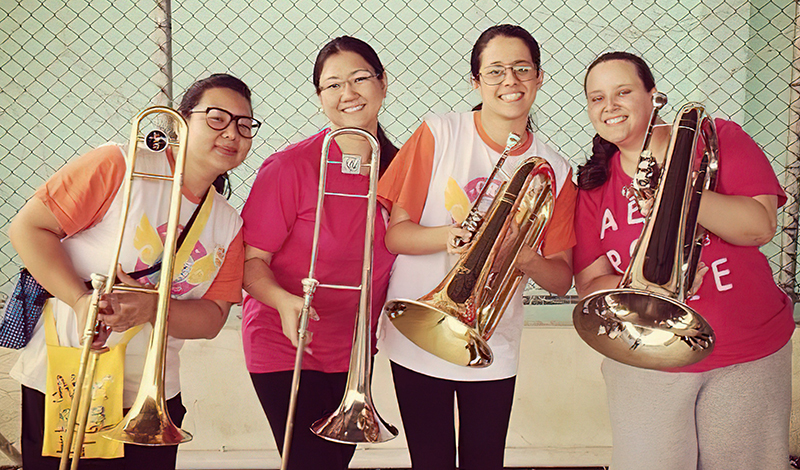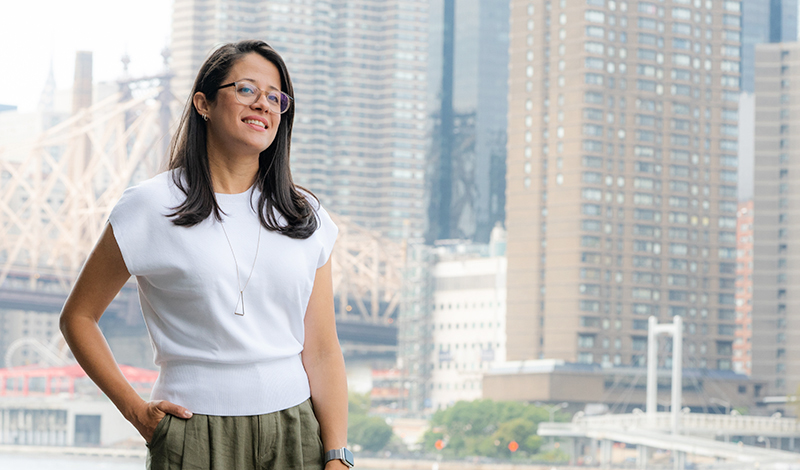by Mariana de Oliveira Moreira
Roosevelt Island, N.Y.
Interview after interview, they turned me down.
“Who have you worked for? How many years in the field? What have you designed?”
In 2016, I was fresh from college, with little architecture experience. What’s more, Brazil was weathering an economic crisis; it seemed that no one was willing to hire me. As a fourth-generation SGI member, I’d been raised with the awareness that my life was precious. Yet, to the people I needed to impress to make a living, it seemed I was not valuable at all.
In tough times, my parents would remind me that if there was something I wanted, I’d need to draw forth strength from within my own life to obtain it. “The Gohonzon is the legacy we have to give you,” they would tell me. “Use this practice to draw forth the strength within your own life to pursue your dreams.”
My parents also never missed their monthly contributions to the SGI, which however humble, were made with gratitude for everything we had overcome. I, too, saved a little money each month to make my own contribution. “This is how we change our financial fortune,” they would tell me.
In difficult times, I would remember the promise I made at age 8 to learn English, a language spoken by people the world over. I had sung for Ikeda Sensei when he came to São Paulo in 1993, his last visit to my country. In his encouragement to us, the members of SGI-Brazil, he asked us to “forge many deep person-to-person ties of friendship and send out the light of hope to the world.” Although we didn’t have the means for me to study English, I grew up pondering these words from Sensei. Each time I made my own modest contribution, I’d think to myself, “This is how I change my financial fortune.” With that fortune, I was determined to see the world.
As one interviewer after another turned me down, an opportunity arose, a job offer from a cousin living in New York. He and his partner needed a babysitter; was I up for it? This, I decided, was my opportunity to learn English.

Upon arrival, I was reminded right away of the ties of friendship connecting the members of the SGI around the world. A former member of Brazil’s Fife and Drum Corps, in which I’d performed throughout my youth, happened to be living in New York. She connected me right away with a Brazilian women’s district leader, who translated for me during discussion meetings.
Evenings, I babysat, and afternoons I spent chanting in one of the open rooms at the New York Culture Center and studying English. Never had I felt so close to Sensei. I remember reading both the Brasil Seikyo in my native tongue and, with difficulty, the World Tribune in English, feeling as though every page were a letter Sensei had written directly to me.
Maybe I looked it up or maybe it was shared with me, but I remember turning again and again to a passage in an essay he wrote in 1999, titled “Morning in New York”:
Giving up is easy. Anyone can quit at any time. But instead, think again and again, suffer and struggle, do what you have to, with everything you’ve got, not sparing an iota of effort. Just do it. No matter how many times you fail, won’t the morning greet you again tomorrow? New York is the “try again” city. (July 2, 2021, World Tribune, p. 3)
As I studied for the notoriously difficult Test of English as a Foreign Language (TOEFL), I soaked up every word of encouragement from both the SGI Brazil and U.S. newspapers. At the same time, I began making sustaining contributions in my adopted country. Each university requires a different TOEFL score of its prospective students. Not only did I pass but far surpassed the required score at my school of choice. With this victory under my belt, I decided to continue my education in New York. Continuing to babysit through school, I’d landed cheap housing in New Jersey, just outside the city limits. Aside from my sustaining contributions, I’d pinched every last penny to save up for a master’s program in sustainability.
While in this program, I encountered and became fascinated by the German concept of a “passive house.” This is a house or building that, by its very design, hugely reduces its ecological footprint. In conversations about planet-warming carbon emissions, we often hear cars and agriculture named as the culprits. So I was astonished to learn that, in the United States, it is in fact buildings—their heating, cooling, lighting, etc.—that emit a third of greenhouse gases. On top of my master’s studies, I began studying for a certification in passive-house design. That year, I was one of just 30% of architects worldwide who took that certification exam and passed it. As the cherry on top, I graduated with flying colors.
However, the battle was not yet won. To stay in the United States, I needed to land a job in my field. I turned again to the Gohonzon with the lion’s roar of Nam-myoho-renge-kyo. When I secured an interview with a company specializing in passive-house design, I poured every iota of my being into a prayer to connect with the interviewers, person to person, life to life.
I was worried, as you can imagine, that they, like every employer in Brazil, would ask me a few questions, find my answers lacking, and dismiss me. I chanted intensely that they see past the surface of my résumé, to who I was as a person.
“You haven’t worked in the field the past five years?” the interviewer asked as he looked over my résumé, arching his brow.
I explained that I’d come to the states to learn English, then pursued my master’s.
“You didn’t speak English when you got here?” he asked.
“No,” I said, and he broke out into a big smile.
“You’re telling me that in five years, you moved to a foreign country, learned English, received your master’s, this additional certificate and went straight into interviews?”
I nodded.
“I don’t need to know anything else,” he said, closing my portfolio. “What I need are capable, proactive people who don’t wait on others to get things done.”
Within the month, I was hired, and benefits came pouring in. Though I was told that my salary would be eligible for an adjustment after three months, they decided to adjust it after just one, saying I was doing what they expected of me after five. They also let me work from home and, just last month, sent me on a training course to Vermont that they usually offer only after a year of employment.
For me, I am living my dream and walking the path of my vow. Working for the health of our planet, the common home of humanity. Together with my SGI family spanning the world, I’m striving alongside my mentor in faith, burning with passion, every iota.
You are reading {{ meterCount }} of {{ meterMax }} free premium articles

